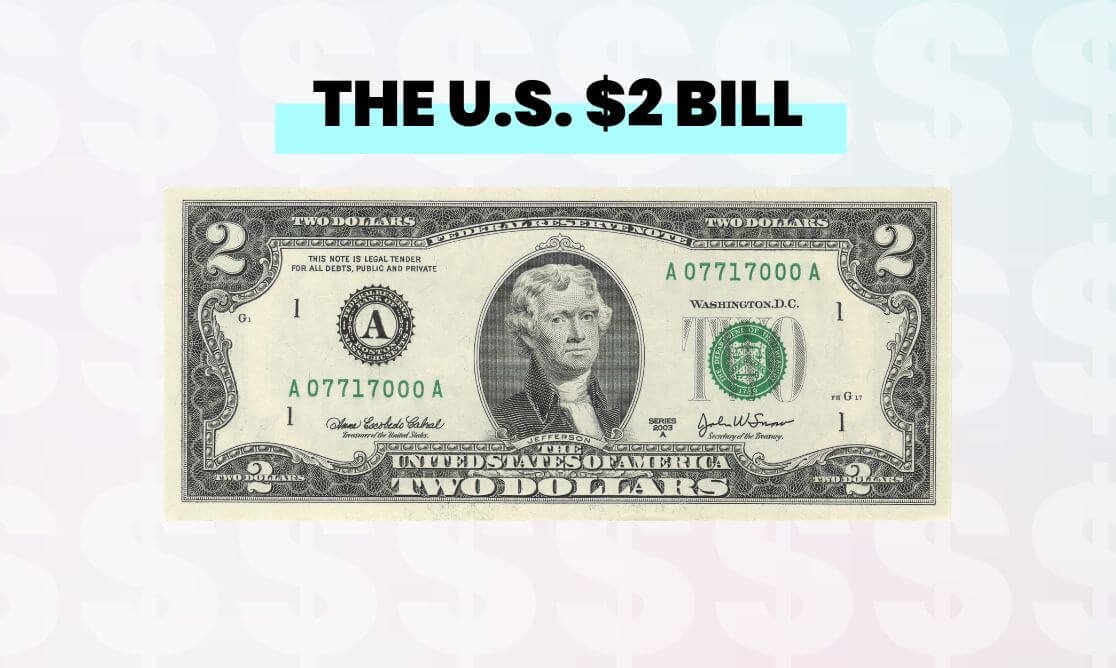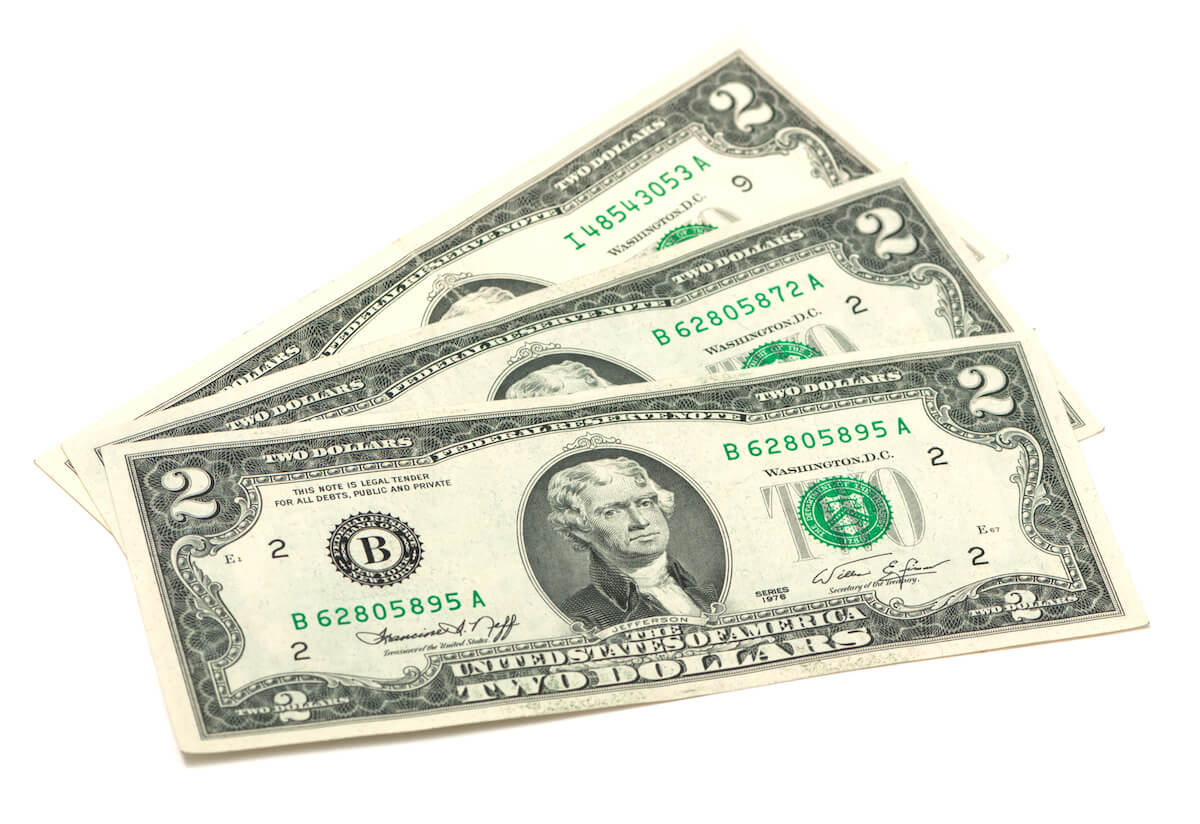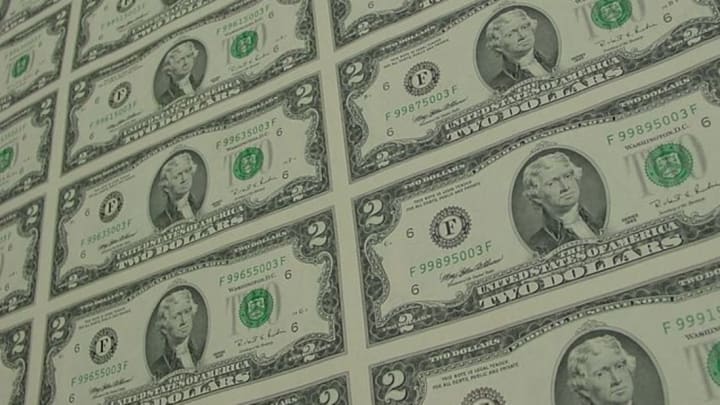:max_bytes(150000):strip_icc()/US0200-Two-Dollar-Bill-series-2003-A-d124f796303247cb8771087fbb98065c.jpg)
In the vast tapestry of American currency, few denominations spark as much curiosity, confusion, and outright fascination as the modest two-dollar bill. Often regarded with a mix of suspicion and mystique, this banknote exists in a peculiar liminal space within our daily transactions – frequently assumed to be out of print, yet consistently produced and, for the discerning eye, occasionally quite valuable. It’s a tale woven through the threads of national history, artistic endeavor, and the evolving habits of a bustling populace.
From its very inception, the $2 bill has embodied a unique chapter in the story of American finance, mirroring the nation’s journey through economic shifts, artistic redesigns, and the ever-present dialogue between government and its citizens. Its story is not merely one of paper and ink, but of the figures it has honored, the historical moments it has commemorated, and the enduring myths it has inspired. Far from being a relic of the past, the $2 bill continues to be a vibrant, albeit often overlooked, piece of circulating legal tender.
Join us on an in-depth exploration as we peel back the layers of misconception and delve into the captivating world of the $2 bill. We will trace its origins, marvel at its diverse designs, understand its periods of prominence and dormancy, and uncover the often-surprising truths behind this distinctive denomination, a true cultural artifact that bridges the past and the present of the United States economy.

1. **The Tangible Essence: Dimensions, Materials, and Security**Every piece of currency tells a story, not just through its imagery, but through its very composition. The United States two-dollar bill, like all modern U.S. currency, is a meticulously crafted artifact designed for durability and security. Before 1929, these notes were considerably larger, measuring approximately 7.375 inches (187.3 mm) in width and 3.125 inches (79.4 mm) in height. However, in 1928, U.S. currency underwent a significant redesign and reduction in size, bringing the $2 bill to its current dimensions of 6.14 inches (approximately 155.95 mm) in width and 2.61 inches (approximately 66.29 mm) in height.
Beyond its dimensions, the material composition of the $2 bill is a testament to its intended longevity. It is not made from ordinary paper, but a unique blend of 75% cotton and 25% linen. This specific ratio gives the banknote its distinctive feel and resilience, allowing it to withstand the rigors of circulation far better than standard paper. This material choice is a critical element in ensuring the integrity and lifespan of the nation’s currency, a feature often taken for granted in our daily transactions.
Security features are paramount in modern currency, and the $2 bill incorporates elements designed to deter counterfeiting. Among these are security fibers, subtly integrated into the paper, which are difficult to replicate. Additionally, raised printing, a tactile feature that can be felt by touch, further enhances the bill’s authenticity. While it might seem like a simple piece of paper, each $2 bill is a complex engineering feat, combining historical design with advanced anti-counterfeiting measures, ensuring its trustworthiness as legal tender.

2. **Iconic Imagery: Thomas Jefferson, Monticello, and the Declaration of Independence**The visual identity of the $2 bill is deeply rooted in American history, featuring figures and events that define the nation’s foundational ideals. On the obverse, or front, of the current $2 note, viewers are greeted by a distinguished portrait of Thomas Jefferson, the third president of the United States, who served from 1801 to 1809. This particular design of Jefferson’s portrait dates back to 1928 and is, remarkably, the oldest of all current U.S. currency designs, a subtle nod to the bill’s deep historical ties.
The reverse side of the $2 bill has seen a significant artistic evolution. Initially, when U.S. currency was redesigned and reduced to its current size in 1928, the reverse featured an engraving of Jefferson’s iconic home, Monticello. This imagery graced the back of the note for decades, symbolizing Jefferson’s architectural genius and his enduring legacy. It became a familiar sight for those who encountered the less common denomination.
However, a pivotal change occurred with the reintroduction of the $2 bill in 1976. As part of its reissuance as a Federal Reserve Note, the reverse design was completely updated. It now proudly displays an engraving of John Trumbull’s renowned painting, “Declaration of Independence” (circa 1818). This powerful image, depicting the moment the Declaration of Independence was presented to the Continental Congress, encapsulates a monumental event in American history and serves as a constant reminder of the nation’s birth and its commitment to liberty.

3. **The Genesis of American Currency: Early Large-Sized Notes (1862-1928)**To truly appreciate the $2 bill’s journey, we must first look back to its origins in the crucible of the American Civil War. The very first two-dollar bill was authorized under an act by the United States Congress and issued in March 1862. This initial issuance marked the beginning of a continuous run for the denomination, which lasted until 1966. In its pre-1929 existence as a large-sized note, the $2 bill was not a singular, unchanging entity but rather a versatile form of currency issued under various classifications, reflecting the diverse financial structures of the era.
Throughout these early decades, the $2 bill appeared in several distinct forms. It was issued as a United States Note, signifying direct government debt. It also circulated as a National Bank Note, issued by chartered banks throughout the country. Furthermore, the denomination took the form of a Silver Certificate, which was redeemable for silver coin or bullion, and a Treasury or “Coin” Note, specifically used for government purchases of silver bullion from the mining industry.
Rounding out its early classifications, the $2 bill was also issued as a Federal Reserve Bank Note, an obligation of specific Federal Reserve Banks. This rich tapestry of issuance types underscores the dynamic and often complex nature of American monetary policy during this period. Each form served a particular economic purpose, contributing to the varied landscape of U.S. currency and imbuing these early $2 bills with unique historical significance and, for collectors, distinct value.

4. **A Pantheon of Portraits: Diverse Figures on Early $2 Bills**While Thomas Jefferson is the most recognized face of the $2 bill today, he was by no means the only historical figure to grace this denomination. The early, large-sized notes featured a fascinating array of prominent Americans, offering a visual chronicle of the nation’s leaders and innovators. The very first $2 bill, issued in March 1862 as a Legal Tender Note, showcased a profile portrait of Alexander Hamilton, the nation’s first Secretary of the Treasury, a different image from the familiar portrait on the $10 bill.
By 1869, Hamilton ceded his place to Thomas Jefferson, whose now-familiar portrait appeared to the left of a vignette of the United States Capitol. However, Jefferson’s tenure wasn’t absolute. In 1886, a new $2 Silver Certificate was introduced, featuring United States Civil War General Winfield Scott Hancock on the left of the obverse. This choice highlighted military valor and national unity during a period of post-Civil War reconstruction.
The “Educational Series” Silver Certificate of 1896, one of the most artistically celebrated series, placed allegorical figures on the obverse, with science presenting steam and electricity to commerce and manufacture. Its reverse, however, featured portraits of two great American innovators: Robert Fulton, known for his steamboat, and Samuel F. B. Morse, the inventor of the telegraph. These choices underscored the nation’s industrial and technological progress, celebrating the minds that propelled America forward.
Further diversity in portraits included U.S. Treasury Secretary William Windom, who appeared on a new $2 Silver Certificate in 1891, and a small portrait of George Washington, surrounded by allegorical figures representing agriculture and mechanics, on the redesigned $2 Silver Certificate of 1899. This revolving cast of characters on the $2 bill vividly illustrates the various national priorities and figures deemed worthy of honor throughout different eras of American history.

5. **Artistry and Allegory: Memorable Large-Sized Series Designs**The large-sized $2 bills issued before 1928 were not only larger in physical dimension but also often grander and more intricate in their artistic designs. These notes represent a period of profound artistic expression in American currency, reflecting cultural values and design aesthetics of their time. The 1869 $2 United States Note, for instance, became affectionately nicknamed the “Rainbow Note” due to its distinctive red, white, and blue colors, incorporating green tinting on the top and left side of the obverse.
Another iconic design from this era is the National Bank Note issued in 1875. This particular note featured a striking image of a woman unfurling a flag and, most notably, a large sideways ‘2’ on the obverse, earning it the memorable moniker “Lazy Deuce.” The reverse of this note presented a somewhat unexpected pairing: Sir Walter Raleigh smoking tobacco alongside an eagle with a shield, blending historical exploration with national symbolism in a unique way.
Perhaps the most celebrated series for its artistic merit was the “Educational Series” Silver Certificate issued in 1896. As previously mentioned, the entire obverse of this note was covered in an exquisite artwork depicting an allegorical figure of science. This comprehensive design transformed the currency into a miniature canvas, elevating it beyond mere legal tender to a work of art that aimed to inspire and educate. The reverse, with its portraits of Fulton and Morse, continued this theme of honoring intellectual achievement.
These elaborate designs, including the ornate patterns surrounding figures or large wording like the “TWO” on the 1890 Treasury Note, were complex and often visually busy. While aesthetically pleasing to many, the Treasury later redesigned the reverse of the 1890 Treasury Note in 1891, incorporating “More open space” due to concerns that its complexity made it “too easy to counterfeit.” This decision highlights the ongoing tension between artistic ambition and practical security in currency design.

6. **The Great Downsizing: The Introduction of Small-Sized Notes (Post-1928)**A pivotal moment in the history of American currency, and specifically for the $2 bill, occurred in 1928. This year marked a sweeping redesign and reduction in the physical size of all U.S. currency, bringing it to the familiar dimensions we recognize today. For the $2 bill, this meant a significant transformation from its earlier, larger forms. Post-1928, the $2 bill was exclusively issued as a United States Note, consolidating its classification for a time.
The new small-sized design maintained a cropped version of Thomas Jefferson’s portrait on the obverse, a continuation of his presence on the note since 1869. The reverse of this new series prominently featured Jefferson’s beloved home, Monticello, solidifying the visual association between the third president and the denomination. A distinctive characteristic of all United States Notes from this period was the use of red ink for the treasury seal and serial numbers, a visual cue that set them apart from other currency types.
Initially, the Series of 1928 $2 bill displayed the red treasury seal superimposed by the United States Note obligation on the left, balanced by a large gray “TWO” on the right. Over the decades, minor design adjustments were made. In 1953, the treasury seal was made smaller and shifted to the right, overlapping the gray “TWO,” while the obligation statement moved to overlay a gray numeral ‘2’. These subtle modifications, while not drastically altering the overall aesthetic, represented ongoing refinements in currency presentation.
Further changes occurred in 1963 with the Series 1963. This series saw the addition of the national motto “IN GOD WE TRUST” to the reverse, positioned above Monticello, reflecting a significant cultural and political shift. Concurrently, the phrase “WILL PAY TO THE BEARER ON DEMAND” was removed from the obverse, a necessary update as silver certificates were soon to cease being redeemable in silver. These design evolutions capture a dynamic period of adjustment in American currency, leading up to a significant, albeit temporary, halt in the $2 bill’s production.



